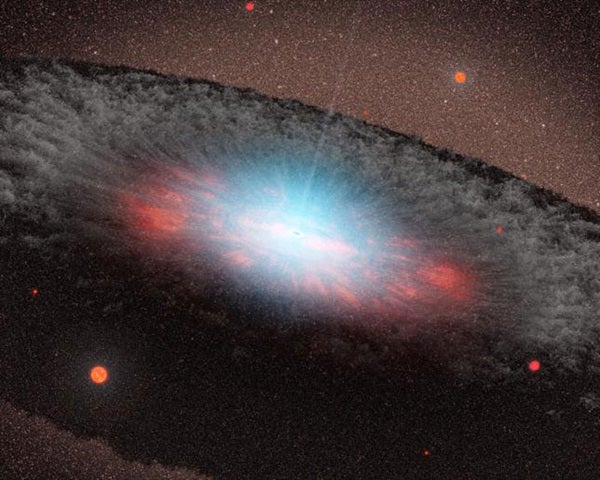The discovery was made using the sensitive radio telescopes of the Institute of Radio Astronomy Millimétrique (IRAM) at the Plateau de Bure in the French Alps. These telescopes were used to search for water vapor in a quasar, a galaxy in the early universe that derives its luminosity from the growth of a black hole hundreds of millions of times more massive than our Sun.
“Water in cosmic clouds is normally frozen to ice, but the ice can be evaporated by the strong radiation of the quasar or of young stars,” said van der Werf. “Therefore, we decided to search for water vapor in this object. It is located so far away that we are looking back in time to an era where the universe was only 10 percent of its present age. This is one of the first searches ever conducted to find water in the early universe.”
The big surprise was, however, not the amount of water vapor found (1,000 trillion times the amount of water on Earth), but the discovery of an opaque disk in which the water vapor is located and that rapidly forms young stars. The density of the disk is so high that light barely escapes. “Water molecules are sensitive to infrared radiation, so we could use the water vapor detected as a cosmic infrared light meter,” said Marco Spaans from the University of Groningen, the Netherlands. “With this method, we found that essentially all radiation is locked up in the gas disk surrounding the black hole. This trapped radiation is so intense that it will build up enormous pressure and eventually blow away the gas and dust clouds surrounding the black hole.”
This conclusion sheds a surprising new light on the connection between black holes and the galaxies in which they reside. “There is a mysterious relation between the masses of black holes in the centers of galaxies and the masses of the galaxies themselves, as if the formation of both is regulated by the same process,” said Alicia Berciano Alba from ASTRON, the Netherlands. “Our results show that these opaque gas disks, which will be ultimately blown away by the intense pressure of the trapped radiation, probably play a key role in this process.”
“This discovery opens new possibilities for studying galaxies in the early universe, using water molecules that probe regions closest to the central black hole that are otherwise difficult to explore,” said Pierre Cox from IRAM.
The team is now looking for water vapor in other objects in the early universe.
The discovery was made using the sensitive radio telescopes of the Institute of Radio Astronomy Millimétrique (IRAM) at the Plateau de Bure in the French Alps. These telescopes were used to search for water vapor in a quasar, a galaxy in the early universe that derives its luminosity from the growth of a black hole hundreds of millions of times more massive than our Sun.
“Water in cosmic clouds is normally frozen to ice, but the ice can be evaporated by the strong radiation of the quasar or of young stars,” said van der Werf. “Therefore, we decided to search for water vapor in this object. It is located so far away that we are looking back in time to an era where the universe was only 10 percent of its present age. This is one of the first searches ever conducted to find water in the early universe.”
The big surprise was, however, not the amount of water vapor found (1,000 trillion times the amount of water on Earth), but the discovery of an opaque disk in which the water vapor is located and that rapidly forms young stars. The density of the disk is so high that light barely escapes. “Water molecules are sensitive to infrared radiation, so we could use the water vapor detected as a cosmic infrared light meter,” said Marco Spaans from the University of Groningen, the Netherlands. “With this method, we found that essentially all radiation is locked up in the gas disk surrounding the black hole. This trapped radiation is so intense that it will build up enormous pressure and eventually blow away the gas and dust clouds surrounding the black hole.”
This conclusion sheds a surprising new light on the connection between black holes and the galaxies in which they reside. “There is a mysterious relation between the masses of black holes in the centers of galaxies and the masses of the galaxies themselves, as if the formation of both is regulated by the same process,” said Alicia Berciano Alba from ASTRON, the Netherlands. “Our results show that these opaque gas disks, which will be ultimately blown away by the intense pressure of the trapped radiation, probably play a key role in this process.”
“This discovery opens new possibilities for studying galaxies in the early universe, using water molecules that probe regions closest to the central black hole that are otherwise difficult to explore,” said Pierre Cox from IRAM.
The team is now looking for water vapor in other objects in the early universe.










